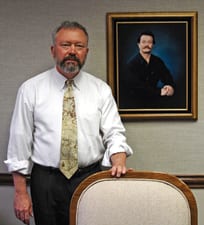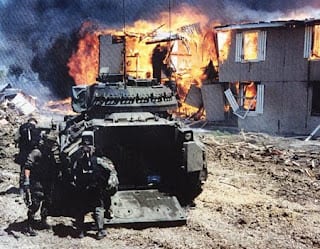
Sara Weaver has forgiven the people responsible for murdering her mother Vicki and younger brother Samuel. Lon Horiuchi, the FBI sniper who shot Vicki in the head while she was holding a ten-month-old infant, is still being sheltered by the Regime that employed him. If he were any part of a man, Horiuchi would make a pilgrimage to Sara’s home in Montana to express remorse for the crimes he committed against her family.
Shortly before he murdered Vicki on August 22, 1992, Horiuchi attempted to murder her husband, Randy Weaver — a man who had done nothing to harm any living soul. Acting under “rules of engagement” that were tantamount to a murder warrant, Horiuchi shot Randy in the back, attempting to kill him instantly by severing his spinal cord.
Owing to a last-second motion by Randy, the bullet hit his shoulder and exited his armpit. Randy and a visiting family friend named Kevin Harris fled back to their cabin. Vicki Weaver flung open the door and was shot in the head by Horiuchi. The same round used to murder Vicki ended up wounding Harris.
At the time Horiuchi attempted to murder him, Randy was visiting the forlorn outbuilding that sheltered the lifeless body of his only son, 14-year-old Samuel, who had been murdered the previous day by U.S. marshals preparing to ambush the Weaver family. Three of the six camouflaged marshals threw rocks to distract the Weaver family’s dogs. When Samuel and Harris went to investigate, a marshal panicked and shot one of the dogs.
After Samuel fired in the direction of the gunshots, Randy told him to return to the cabin.
“I’m coming, Dad,” shouted Samuel.
At that point, one of the marshals, in keeping with the standards of valor expected of those who serve the federal Leviathan, shot the 14-year-old in the back.
In what a jury later found to be a lawful use of defensive force, Harris returned fire. Deputy Marshal William Degan was killed in the gunfight. The Feds claimed that he was killed in the first shot of the skirmish. This was a lie, of course: He had fired at least seven rounds before stopping one, and it’s likely that he was killed by “friendly fire.”
For nine days, Sara had to care for her baby sister, Elishiba, as well as her ten-year-old sister Rachel while the shattered body of her mother decomposed in the family’s cabin. Their home — or “compound,” as it was characterized by the criminals who besieged it, and the media functionaries who retailed their self-serving lies — was surrounded by a small army of federal, state, and local law enforcement personnel.
Sara and the other survivors also had to endure the mocking sadism of the FBI agents who had murdered Vicki and Samuel. One morning they were awoken by a taunting message broadcast over a loudspeaker: “Good morning, Mrs. Weaver. We had pancakes for breakfast. What did you have?”
In what could be seen as a foreshadowing of the holocaust at Waco’s Branch Davidian refuge roughly eight months later, the Feds were apparently prepared to fire-bomb the Weaver home, thereby destroying evidence of their crimes. A news crew from KREM-TV in Spokane saw several large canisters of gasoline being loaded onto an FBI helicopter, which took off and circled the cabin — only to veer off suddenly after being videotaped by observers on the ground.
Much to the disappointment of the Feds, the standoff ended without additional bloodshed. Randy Weaver and Kevin Harris were acquitted of murder charges arising from the death of William Degan. Randy was found guilty of failing to appear in court to answer a contrived firearms charge engineered by an ATF provocateur who sought to blackmail the ex-Green Beret into becoming an informant.
Although the Weaver family eventually received a large civil settlement courtesy of the federal government’s tax victims, neither Horiuchi nor his supervisors — Larry Potts and Danny Coulson — were never prosecuted. The Ninth Circuit Court of Appeals, invoking a specious concept it called “Supremacy Clause Immunity,” ruled that it would be impermissible for a federal law enforcement officer to face civil or criminal prosecution for official acts that would otherwise be criminal in nature. Judge Alex Kozinski’s scalding dissent lambasted the court for creating what he christened the “007 Standard” — a license to kill that was issued “to all law enforcement agencies in our circuit — federal, state, and local.”
A few months after issuing that ruling, the court modified it to permit the State of Idaho to prosecute Horiuchi under state laws. Denise Woodbury, an assistant prosecutor from Boundary County, was prepared to put Horiuchi on trial, but the prospect of doing so caused incoming county attorney Brett Benson to lose bladder control. Accordingly, the individual who murdered Vicki Weaver and attempted to murder Randy Weaver remains at large.
In addition, Senior FBI executives received cash bonuses and promotions while under investigation for suspected misconduct in the Ruby Ridge debacle. The Justice Department’s Office of the Inspector General said in a report that bonuses and promotions went to former FBI Deputy Director Larry A. Potts, later demoted and suspended for improper oversight of the deadly siege; and E. Michael Kahoe, a senior FBI executive sentenced to prison for destroying a critical Ruby Ridge document. Other cash awards and promotions, the report said, went to Danny O. Coulson, former deputy assistant director who worked for Mr. Potts; and three senior FBI executives, Charles Mathews, Robert E. Walsh and Van A. Harp, accused of not conducting proper after-the-fact investigations to determine what happened at Ruby Ridge.
As the indispensable James Bovard pointed out sixteen years ago, the Marshals Service “gave its highest award for valor” to the five surviving members of the home invasion squad that murdered Samuel Weaver. In presenting the award, then-director Eduardo Gonzalez hymned the praises of the “exceptional courage … sound judgment in the face of attack, and … high degree of professional competence” displayed by the agents whose actions precipitated the needless
deaths of three people, and the attempted murder of two others.
Prior to the killings at Ruby Ridge, the Marshals Service had spent a year and a half spying on the impoverished, isolated Weaver family. This included multiple acts of criminal trespass and the creation of a network of remote-operated surveillance cameras on the high ground above the family’s land. Weaver was considered a fugitive for missing a court hearing after being issued two summonses giving two different dates. He was to stand trial on firearms charges after being entrapped by the ATF, which sought to blackmail him into becoming a federal informant inside the Aryan Nation white supremacist organization.
Weaver’s first encounter with the Feds came in July 1985, when he was visited by the Secret Service after a neighbor accused him of threatening the life of President Reagan. Rather than filing charges against Weaver, the Feds opened a file on him. Four years later, an ATF undercover informant-provocateur named Gus Magisano (who used the pseudonym “Kenneth Faderly”) made a business proposal to Weaver: He offered to buy several shotguns from him if the barrels were sawed off to his specifications.
With his family practically starving, Weaver was a motivated seller. His customer was an eager buyer — but he was also curiously specific regarding the modifications he wanted on the guns, demanding that Weaver saw off the barrels at a particular length. Those “illegal” alterations — which left the barrels longer than those on the sixty Remington 870 pump-action shotguns ordered by the IRS a few years ago — offered the ATF what it thought was sufficient leverage to blackmail Weaver.
In January 1990, Weaver was visited by ATF Agents Herbert Byerly and Steve Gunderson, who threatened to prosecute him unless he became an informant. To his eternal credit, Weaver invited them to inseminate themselves. Since defiance of that kind simply couldn’t be tolerated, the ATF, acting with the U.S. Marshals Service and several state and local agencies, initiated the low-intensity war against the Weaver family that eventually claimed the lives of Vicki and Samuel.

Salt Lake attorney Jesse Trentadue explains that the federal jihad against the Weavers was an outgrowth of an FBI initiative called PATCON, or “Patriot Conspiracy.” The campaign was designed “to infiltrate and incite the milita and evangelical Christians to violence so that the Department of Justice could crush them.”
“Ruby Ridge was a PATCON operation,” Trentadue observes. “Waco was a PATCON operation. And so, too, I believe was the Oklahoma City Bombing.”
Trentadue’s understanding of PATCON is the product of long, arduous investigation of the FBI’s role in inciting domestic terrorism and covering up its officially sanctioned misdeeds. He is a singularly tenacious and motivated investigator: His brother, the late Kenneth Trentadue, was murdered by the FBI in an Oklahoma prison cell on August 21, 1995, after being mistaken for a bank robber named Richard Lee Guthrie, who was part of a PATCON-connected gang called the Aryan Republican Army.
“The only difference between the FBI and the KGB,” Jesse Trentadue wearily concludes, “is that the Soviet secret police never pretended to be a legitimate law enforcement agency.” That observation was shared on August 21 — twenty years after federal marshals murdered Samuel Weaver, and the seventeenth anniversary of the torture-murder of Kenneth Trentadue, both of whom were victims of the FBI’s ongoing PATCON initiative.
Sources:
- http://911truth.org/ruby-ridge-the-age-of-state-terrorism-begins/
- http://www.apfn.org/apfn/rubyridge.htm
Recommended Reading / Videos:
 On the last hot day of summer in 1992, gunfire cracked over a rocky knob in northern Idaho, just south of the Canadian border. By the next day three people were dead, and a small war was joined, pitting the full might of federal law enforcement against one well-armed family. Drawing on extensive interviews with Randy Weaver’s family, government insiders, and others, Jess Walter traces the paths that led the Weavers to their confrontation with federal agents and led the government to treat a family like a gang of criminals.
On the last hot day of summer in 1992, gunfire cracked over a rocky knob in northern Idaho, just south of the Canadian border. By the next day three people were dead, and a small war was joined, pitting the full might of federal law enforcement against one well-armed family. Drawing on extensive interviews with Randy Weaver’s family, government insiders, and others, Jess Walter traces the paths that led the Weavers to their confrontation with federal agents and led the government to treat a family like a gang of criminals.
This is the story of what happened on Ruby Ridge: the tragic and unlikely series of events that destroyed a family, brought down the number-two man in the FBI, and left in its wake a nation increasingly attuned to the dangers of unchecked federal power.
 AUGUST 21, 1992: A SIX-MAN TEAM from the Special Operations Group of the U.S. Marshals Service, dressed in full regalia and armed with silenced automatic weapons, moved onto Randy Weaver’s 20-acre property known as Ruby Ridge. In less than 36 hours they had killed his son and an FBI sniper had shot his wife as she stood in the door of the cabin holding her 10-month-old-baby. Almost immediately the agents declared a hostage situation and a massive paramilitary buildup began, which eventually reached more than 400 heavily armed agents, including most of the FBI Hostage Rescue Team, and a large array of assault vehicles and weaponry.
AUGUST 21, 1992: A SIX-MAN TEAM from the Special Operations Group of the U.S. Marshals Service, dressed in full regalia and armed with silenced automatic weapons, moved onto Randy Weaver’s 20-acre property known as Ruby Ridge. In less than 36 hours they had killed his son and an FBI sniper had shot his wife as she stood in the door of the cabin holding her 10-month-old-baby. Almost immediately the agents declared a hostage situation and a massive paramilitary buildup began, which eventually reached more than 400 heavily armed agents, including most of the FBI Hostage Rescue Team, and a large array of assault vehicles and weaponry.
Ambush at Ruby Ridge: How Government Agents Set Randy Weaver Up and Took His Family Down chronicles the U.S. Marshals Service elaborate, multi-million-dollar 18-month surveillance of Weaver, an Idaho backwoods resident known as a white separatist, indicted on a minor firearms charge many claim was a government act of hatred and blackmail. The resultant 11-day standoff in Weaver’s small family cabin and the paramilitary attack that ensued are described through graphic and closely documented accounts: from the details surrounding the initial siege to the shoot-to-kill orders given by FBI headquarters.
Through court transcripts, private testimonies and interviews with insiders, local residents, and friends of the Weaver Family, jounalist Alan Bock debunks the myth that government agencies are beyond the realm of entrapment, cover-ups, and even the killing of innocent people. He overturns the hypocrisies and contradictions of the FBI, and takes you straight to the scene-first, to the tragedy of Ruby Ridge, then to the colorful neo-Nazi and protester-filled roadblock, and finally to the courtroom, where prosecutors and flamboyant defense attorney Gerry Spence go head to head.
But beyond being a shocking account of bizarre circumstances, Ambush at Ruby Ridge challenges the personal and political implications of the most notorious trial in Idaho history. Maybe if the ambush on David Koresh’s Branch Davidian cult in Waco, Texas, hadn’t happened as the Weaver trial was underway. the events of Ruby Ridge might be seen as a regional story of government bungling with tragic results. But Waco did happen, causing many Americans to ask hard and fundamental questions about what the United States Government has become. Unlike with Waco, the government may actually be held accountable for what it did at Ruby Ridge.
 Excerpt Chapter 1: “This is my story…watered with tears, defined by pain, reborn with the hope that it can help others. But it wasn’t always that way…
Excerpt Chapter 1: “This is my story…watered with tears, defined by pain, reborn with the hope that it can help others. But it wasn’t always that way…
My earliest memories of childhood are wrapped in the comfort of an ideal American family, rooted in rich black soil of the mid-west. My grandparents owned and operated a small farm in Iowa, cultivating corn and soybeans and raising cattle and hogs. We would travel the two-plus hours from our home in Cedar Falls to “Grandpa’s farm” in Fort Dodge.
This was where my mother Vicki grew up; a world of tall corn, green fields, red barns, juicy tomatoes and smelly obnoxious hogs. It was where I and my little brother Sam would promptly climb the cherry tree with our many cousins and stuff ourselves silly on sour pie cherries. From there we would head to the barn and, despite Grandpa’s warnings get scratched by the wild kitties we just knew we could tame…..My memories are fond of that farm–intricate and colorful, in blocks, like one of my mother’s hand sewn quilts.”
Excerpt Chapter 8: “I blinked and waited. I was sure there would be shots fired that would kill the rest of us. We started down the steps from the back porch, and still I waited. Unbelievably, I heard nothing. We began to walk away from the cabin. The cabin had been my home since I was just a child. All of my happy memories were forever obscured by a huge black cloud of sorrow and pain that would doggedly follow me forever.”
Excerpt Chapter 14: “It has been indescribable to live my life in the light and grace of God’s love and peace. I now understand that He has a perfect plan for my life and He is the reason I am free. He is the only reason I am still here, the reason I did not die at Ruby Ridge. He has a plan and all I have to to do is choose to trust Him, one day at a time.
I want to make clear that I have not “arrived.” I am still a work in progress and I praise Him for His patience with me. I still have hard days, but the difference now is that I know I am not alone in them. I know He is taking care of me. I know those hard days are growing me and molding me into who He wants me to be. More often than not, the hard things I experience and choose to give to Him and learn from, are for the benefit of helping someone else who is struggling. That is the greatest gift of all–to know that the pain and struggles we experience can be for a greater purpose and, in essence, know that what we have been through was not in vain, not for nothing. This takes care of the echoing questions of “why?” in our lives. There may not always be a perfect explanation, and for many things, we may only completely understand when we reach heaven and all is ultimately revealed.”
https://www.youtube.com/watch?v=kvQUNBUsyHE&feature=youtu.be&t=7m4s



